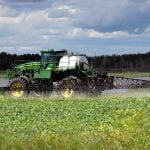When fresh milk leaves a dairy farm, it can end up in a range of food products, including cheese, sour cream, ice cream, yogurt, butter or milk.
But because it’s highly perishable, quality control measures greet it at every turn.
“It’s tested for butterfat, protein and inhibitors before it even goes into the plant itself. They do that when the milk is still on the truck,” said Debbie Hofstra, with the Alberta Dairy Council in Edmonton.
“Then the milk goes into a holding tank, and it’s pasteurized and homogenized before anything further is done to it.”
Read Also

VIDEO: Green Lightning and Nytro Ag win sustainability innovation award
Nytro Ag Corp and Green Lightning recieved an innovation award at Ag in Motion 2025 for the Green Lightning Nitrogen Machine, which converts atmospheric nitrogen into a plant-usable form.
Hofstra says all milk for sale is pasteurized, where it’s heated to a certain temperature, but below boiling point, for a certain length of time. This process kills bacteria or spoilage organisms.
Typical pasteurization protocols may include heating to 60 C for a minimum of 30 minutes, or 72 C for a minimum of 16 seconds. Milk can be pasteurized in batches or in continuous systems.
Homogenization ensures the butterfat doesn’t separate and consumers don’t get a cream line on top of the milk.
“In skim milk, you don’t have that but in whole milk, that’s 3.2 or 3.5 percent cream. After homogenization, the milk doesn’t separate anymore with the cream coming to the top.”
Because milk is an oil-in-water emulsion, it tends to separate into cream on top and water on the bottom. Homogenization is a mechanical process that uses pressure to break large fat globules into many, much smaller fat globules.
In fresh milk, the globules range from
one to 20 microns in diameter. After homogenization, they average around one micron in diameter and can remain dispersed through the milk in a stable manner.
At the end of the process, the milk has more uniform, smaller fat globules that are less likely to separate out.
Milk can be processed into fluid products, butter, ice cream or cultured products like sour cream and yogurt. If it’s a milk plant, a cheese plant or a cultured product plant, it’s handled a little bit differently.
“Anything pourable will come out of a fluid milk plant. All your milks, from skim to whole milk, creams, half and halfs, eggnogs, buttermilk and such,” said Hofstra.
“After homogenization, a certain proportion of cream is removed to produce the standard skim, one percent, two percent or whole milk. Your cream would go another direction and be put into whipping creams, half and halfs, coffee creams and so forth.”
Butter production is a different process. Usually a butter plant produces only butter. Hofstra said the provincial butterfat average in Alberta is 3.5 to 3.6 percent.
“At a cheese plant, they take off the butterfat and the protein. The higher the protein, the better the cheese.”
BUTTER 101
Many kinds of butter have evolved over the years to suit different tastes and uses.
Here are the most common ones:
* Churned butter: Traditional butter.
* Cultured butter: Made from cream to which a bacterial culture has been added before churning. It may be salted or unsalted. Sometimes called “old fashioned” or “antique” butter.
* Light butter: Contains at least 25 percent less butterfat than traditional butter. Made lighter with the addition of air and water.
Not recommended on hot toast or popcorn because of its higher moisture content. Not the best choice for cooking or in sauces or recipes that require larger amounts of fat.
* Flavoured butters: Salted butters to which garlic, spices or herbs have been added.
* Sweet butter: Made without salt.
* Whipped butter: Air has been beaten in, giving it more volume and making it spread more easily. It should not be used in recipes calling for plain butter.
* Ghee: A semi-fluid type of clarified butter that originated in eastern cultures and is used especially in Indian cookery. Because the milk solids have been removed, it keeps longer at room temperature.
Source: Dairy Farmers of Canada














